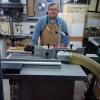Hey all,
I'm pretty new to woodworking, only really getting shown my first taste in interest this past year while trying to do a few kitchen upgrades.
I think I would like to dabble in fine woodworking I guess you would call it, with my major end goal being one day to make my own set of presentable kitchen cabinets. And I'm sure if I can get the hang of it, it'll blow up into a full blown hobby with many different projects.
Anyways, enough rambling. My main question is what is the difference between a router and a table, and a shaper? With a level playing field on power- say 3hp just for example- what makes these two so different that both machines exist? I know a shaper is a fixed machine? With a larger arbor and different bits- but that's about the extent of my knowledge.
Thanks!
Adam




 Reply With Quote
Reply With Quote






